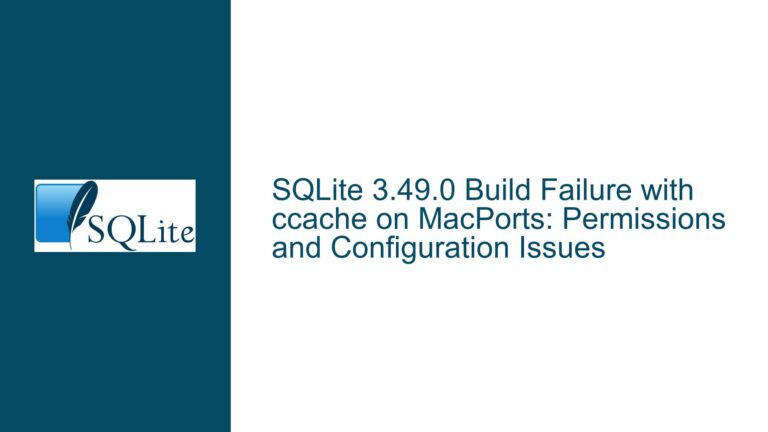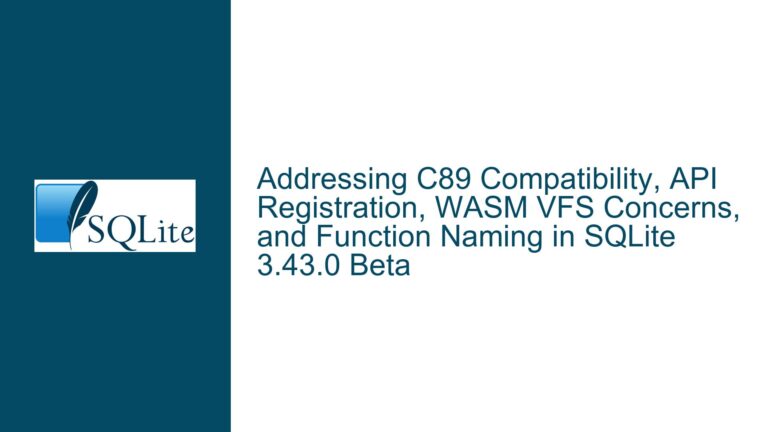SQLite Python Binding Error: Incorrect Number of Bindings Supplied
SQLite Python Binding Error During DELETE Operation
When working with SQLite in Python, a common issue arises when executing DELETE operations with parameterized queries. Specifically, the error sqlite3.ProgrammingError: Incorrect number of bindings supplied. The current statement uses 1, and there are 2 supplied can occur. This error is particularly perplexing because it suggests that the number of parameters provided does not match the number of placeholders in the SQL query. However, the root cause is often related to how Python handles strings and sequences when binding parameters to SQL statements.
In the context of the provided discussion, the issue manifests when attempting to delete a row from an SQLite database using a Python script. The script initially works for a single-character rowid but fails when the rowid is a multi-character string. This discrepancy is due to the way Python interprets strings as sequences of characters, leading to an incorrect number of bindings being supplied to the SQL query.
String Sequences and Parameter Binding Mismatch
The core of the problem lies in the interaction between Python’s handling of strings and SQLite’s parameter binding mechanism. In Python, strings are sequences of characters. When a string is passed as a parameter to a SQLite query, Python interprets each character in the string as a separate element in the sequence. This interpretation leads to a mismatch between the number of placeholders in the SQL query and the number of elements in the sequence.
For example, consider the following SQL query:
DELETE FROM adressen WHERE rowid = ?;
This query expects a single parameter to be bound to the placeholder ?. However, if the parameter is a string like '69', Python interprets this as a sequence of two characters: '6' and '9'. As a result, SQLite receives two elements to bind to a single placeholder, leading to the Incorrect number of bindings supplied error.
This issue is further compounded by the fact that SQLite’s rowid is typically an integer, but the parameter being passed is a string. While SQLite can implicitly convert strings to integers in some contexts, the primary issue here is the sequence interpretation rather than the data type.
Correcting Parameter Binding with Tuples and Lists
To resolve the issue, it is essential to ensure that the parameter passed to the SQLite query is a single-element sequence, such as a tuple or a list. This approach prevents Python from interpreting the string as a sequence of characters and ensures that only one element is bound to the placeholder in the SQL query.
The correct way to pass the parameter is to use a single-element tuple or list:
c.execute("DELETE FROM adressen WHERE rowid = ?;", (id,))
or
c.execute("DELETE FROM adressen WHERE rowid = ?;", [id])
In both cases, the parameter id is wrapped in a single-element sequence, ensuring that only one element is bound to the placeholder in the SQL query. This approach works regardless of whether id is a single-character or multi-character string.
Additionally, it is good practice to convert the id to an integer before passing it to the SQL query, as rowid is typically an integer. This conversion can be done using the int() function:
c.execute("DELETE FROM adressen WHERE rowid = ?;", (int(id),))
This ensures that the parameter is correctly interpreted as an integer, aligning with the expected data type for rowid.
Detailed Explanation of the Solution
To fully understand the solution, it is important to delve into the mechanics of parameter binding in SQLite and Python. When a parameterized query is executed, the SQLite library expects a sequence of parameters that match the number of placeholders in the query. The placeholders are typically represented by ? in the SQL statement.
In Python, the sqlite3.Cursor.execute method accepts two arguments: the SQL query and a sequence of parameters. The sequence can be a tuple, list, or any other iterable that provides the necessary parameters. The key point is that the sequence must contain exactly as many elements as there are placeholders in the SQL query.
When a string is passed as the parameter, Python treats it as a sequence of characters. For example, the string '69' is treated as a sequence containing two elements: '6' and '9'. This behavior is consistent with Python’s general treatment of strings as sequences of characters. However, this interpretation leads to a mismatch when the SQL query expects only one parameter.
By wrapping the parameter in a single-element tuple or list, we ensure that the sequence contains exactly one element, regardless of the length of the string. This approach aligns with the expectations of the SQLite library and prevents the Incorrect number of bindings supplied error.
Practical Implications and Best Practices
Understanding this issue has broader implications for working with SQLite in Python. It highlights the importance of correctly handling parameter binding, especially when dealing with different data types and sequences. Here are some best practices to avoid similar issues:
Always Use Sequences for Parameter Binding: When passing parameters to a SQLite query, always use a sequence (tuple or list) even if there is only one parameter. This ensures that the parameter is correctly interpreted as a single element.
Convert Data Types Appropriately: Ensure that the data types of the parameters match the expected types in the SQL query. For example, convert strings to integers when working with
rowid.Use Parameterized Queries: Always use parameterized queries to prevent SQL injection attacks and ensure that parameters are correctly bound to placeholders.
Test with Different Inputs: Test your code with a variety of inputs, including edge cases, to ensure that it handles all scenarios correctly.
Understand Python’s Sequence Handling: Be aware of how Python handles different types of sequences, especially strings, to avoid unexpected behavior in parameter binding.
Example Implementation
To illustrate the correct implementation, consider the following Python script that deletes a row from an SQLite database based on the rowid:
import sqlite3
def delete_address(id):
# Connect to the database and create a cursor
conn = sqlite3.connect('adressen.db')
c = conn.cursor()
# Execute the DELETE query with the correct parameter binding
c.execute("DELETE FROM adressen WHERE rowid = ?;", (int(id),))
# Commit the transaction
conn.commit()
# Close the connection
conn.close()
# Example usage
delete_address('69')
In this script, the delete_address function takes an id as a parameter, converts it to an integer, and passes it as a single-element tuple to the execute method. This ensures that the parameter is correctly bound to the placeholder in the SQL query, avoiding the Incorrect number of bindings supplied error.
Conclusion
The Incorrect number of bindings supplied error in SQLite with Python is a common issue that arises from the interaction between Python’s sequence handling and SQLite’s parameter binding mechanism. By understanding the root cause and implementing the correct parameter binding approach, this issue can be easily resolved. The key takeaway is to always use sequences (tuples or lists) for parameter binding and ensure that the data types of the parameters match the expected types in the SQL query. Following these best practices will help avoid similar issues and ensure robust and reliable database operations in Python.






